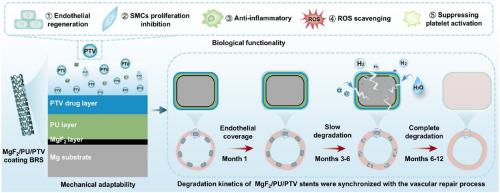A hierarchical MgF2/polyurethane/pitavastatin coating alleviates degradation and enhances endothelialization of bioresorbable magnesium alloy stents
IF 18
1区 医学
Q1 ENGINEERING, BIOMEDICAL
引用次数: 0
Abstract
Rare-earth-free magnesium (Mg) alloy bioresorbable stent (BRS) exhibits significant potential in vascular intervention due to its exceptional biosafety. However, its susceptibility to corrosion complicates surface functionalization and renders existing coating strategies ineffective for degradation-remodeling kinetics, resulting in delayed re-endothelialization and excessive lumen loss. Herein, a hierarchical MgF2/polyurethane (PU)/pitavastatin (PTV) coating system is constructed on Mg-Zn-Mn BRS using elastomeric PU as an intermediate layer. Studies confirm the PU layer effectively accommodates stent deformation, alleviates stress concentrations, and confines corrosion propagation triggered by deformation-induced MgF2 microcracks. The in situ formed MgF2 layer concurrently decreases substrate reactivity, establishes stable interfaces with PU, and synergistically enhances the corrosion resistance. The surface PTV-loaded poly-L-lactic acid layer maintains sustained drug release through PU-mediated interfacial stability while serving as an initial corrosion barrier. In vivo evaluations demonstrate the MgF2/PU/PTV-functionalized stent significantly suppresses neointimal hyperplasia in rabbit models while achieving synchronized degradation-remodeling kinetics. This hierarchical coating architecture, which synergistically integrates controlled drug elution with degradation modulation, provides a viable solution to clinical challenges of post-implant restenosis and vascular remodeling mismatch.

多层MgF2/聚氨酯/匹伐他汀涂层减轻了生物可吸收镁合金支架的降解并增强了内皮化
无稀土镁(Mg)合金生物可吸收支架(BRS)因其优异的生物安全性在血管介入治疗中显示出巨大的潜力。然而,其对腐蚀的敏感性使其表面功能化复杂化,并使现有的涂层策略对降解重塑动力学无效,导致再内皮化延迟和过多的管腔损失。本文以弹性PU为中间层,在Mg-Zn-Mn BRS上构建了MgF2/聚氨酯(PU)/匹伐他汀(PTV)分层涂层体系。研究证实,PU层能有效调节支架变形,缓解应力集中,限制变形诱导的MgF2微裂纹引发的腐蚀扩展。原位形成的MgF2层同时降低了衬底反应性,与PU建立了稳定的界面,并协同增强了耐腐蚀性。表面ptv负载的聚l -乳酸层通过pu介导的界面稳定性维持持续的药物释放,同时作为初始腐蚀屏障。体内评估表明,MgF2/PU/ ptv功能化支架在兔模型中显著抑制新生内膜增生,同时实现同步降解-重塑动力学。这种分层涂层结构协同整合了受控药物洗脱和降解调节,为种植体后再狭窄和血管重构不匹配的临床挑战提供了可行的解决方案。
本文章由计算机程序翻译,如有差异,请以英文原文为准。
求助全文
约1分钟内获得全文
求助全文
来源期刊

Bioactive Materials
Biochemistry, Genetics and Molecular Biology-Biotechnology
CiteScore
28.00
自引率
6.30%
发文量
436
审稿时长
20 days
期刊介绍:
Bioactive Materials is a peer-reviewed research publication that focuses on advancements in bioactive materials. The journal accepts research papers, reviews, and rapid communications in the field of next-generation biomaterials that interact with cells, tissues, and organs in various living organisms.
The primary goal of Bioactive Materials is to promote the science and engineering of biomaterials that exhibit adaptiveness to the biological environment. These materials are specifically designed to stimulate or direct appropriate cell and tissue responses or regulate interactions with microorganisms.
The journal covers a wide range of bioactive materials, including those that are engineered or designed in terms of their physical form (e.g. particulate, fiber), topology (e.g. porosity, surface roughness), or dimensions (ranging from macro to nano-scales). Contributions are sought from the following categories of bioactive materials:
Bioactive metals and alloys
Bioactive inorganics: ceramics, glasses, and carbon-based materials
Bioactive polymers and gels
Bioactive materials derived from natural sources
Bioactive composites
These materials find applications in human and veterinary medicine, such as implants, tissue engineering scaffolds, cell/drug/gene carriers, as well as imaging and sensing devices.
 求助内容:
求助内容: 应助结果提醒方式:
应助结果提醒方式:


